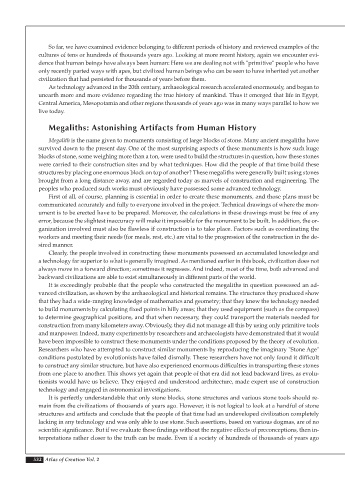Page 534 - Atlas of Creation Volume 2
P. 534
So far, we have examined evidence belonging to different periods of history and reviewed examples of the
cultures of tens or hundreds of thousands years ago. Looking at more recent history, again we encounter evi-
dence that human beings have always been human: Here we are dealing not with "primitive" people who have
only recently parted ways with apes, but civilized human beings who can be seen to have inherited yet another
civilization that had persisted for thousands of years before them.
As technology advanced in the 20th century, archaeological research accelerated enormously, and began to
unearth more and more evidence regarding the true history of mankind. Thus it emerged that life in Egypt,
Central America, Mesopotamia and other regions thousands of years ago was in many ways parallel to how we
live today.
Megaliths: Astonishing Artifacts from Human History
Megalith is the name given to monuments consisting of large blocks of stone. Many ancient megaliths have
survived down to the present day. One of the most surprising aspects of these monuments is how such huge
blocks of stone, some weighing more than a ton, were used to build the structures in question, how these stones
were carried to their construction sites and by what techniques. How did the people of that time build these
structures by placing one enormous block on top of another? These megaliths were generally built using stones
brought from a long distance away, and are regarded today as marvels of construction and engineering. The
peoples who produced such works must obviously have possessed some advanced technology.
First of all, of course, planning is essential in order to create these monuments, and those plans must be
communicated accurately and fully to everyone involved in the project. Technical drawings of where the mon-
ument is to be erected have to be prepared. Moreover, the calculations in these drawings must be free of any
error, because the slightest inaccuracy will make it impossible for the monument to be built. In addition, the or-
ganization involved must also be flawless if construction is to take place. Factors such as coordinating the
workers and meeting their needs (for meals, rest, etc.) are vital to the progression of the construction in the de-
sired manner.
Clearly, the people involved in constructing these monuments possessed an accumulated knowledge and
a technology far superior to what is generally imagined. As mentioned earlier in this book, civilization does not
always move in a forward direction; sometimes it regresses. And indeed, most of the time, both advanced and
backward civilizations are able to exist simultaneously in different parts of the world.
It is exceedingly probable that the people who constructed the megaliths in question possessed an ad-
vanced civilization, as shown by the archaeological and historical remains. The structures they produced show
that they had a wide-ranging knowledge of mathematics and geometry; that they knew the technology needed
to build monuments by calculating fixed points in hilly areas; that they used equipment (such as the compass)
to determine geographical positions, and that when necessary, they could transport the materials needed for
construction from many kilometers away. Obviously, they did not manage all this by using only primitive tools
and manpower. Indeed, many experiments by researchers and archaeologists have demonstrated that it would
have been impossible to construct these monuments under the conditions proposed by the theory of evolution.
Researchers who have attempted to construct similar monuments by reproducing the imaginary "Stone Age"
conditions postulated by evolutionists have failed dismally. These researchers have not only found it difficult
to construct any similar structure, but have also experienced enormous difficulties in transporting these stones
from one place to another. This shows yet again that people of that era did not lead backward lives, as evolu-
tionists would have us believe. They enjoyed and understood architecture, made expert use of construction
technology and engaged in astronomical investigations.
It is perfectly understandable that only stone blocks, stone structures and various stone tools should re-
main from the civilizations of thousands of years ago. However, it is not logical to look at a handful of stone
structures and artifacts and conclude that the people of that time had an undeveloped civilization completely
lacking in any technology and was only able to use stone. Such assertions, based on various dogmas, are of no
scientific significance. But if we evaluate these findings without the negative effects of preconceptions, then in-
terpretations rather closer to the truth can be made. Even if a society of hundreds of thousands of years ago
532 Atlas of Creation Vol. 2

